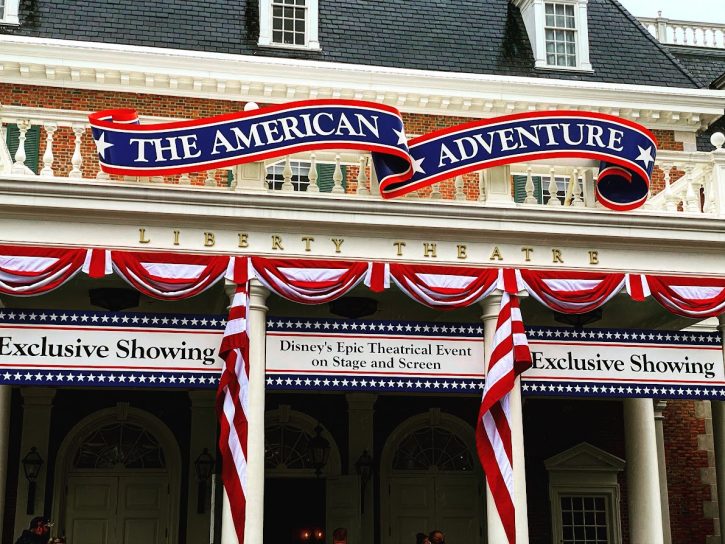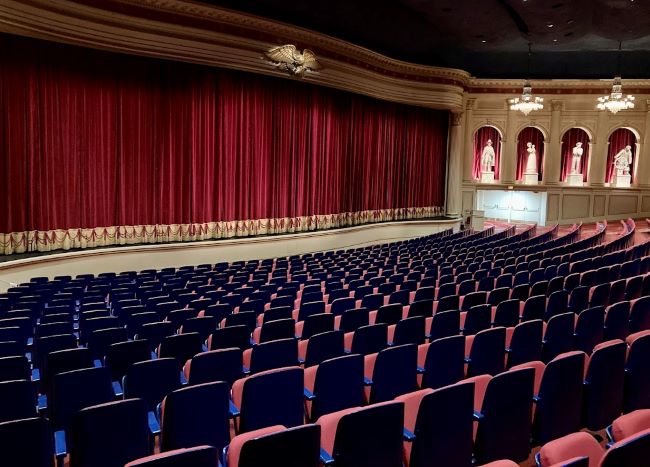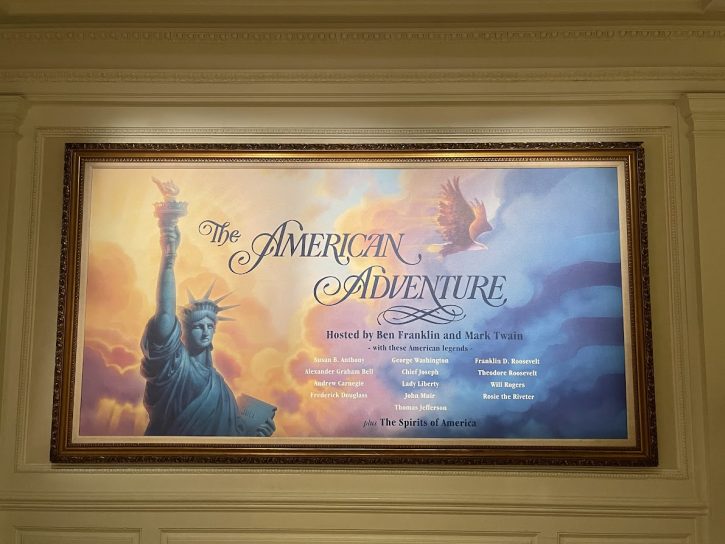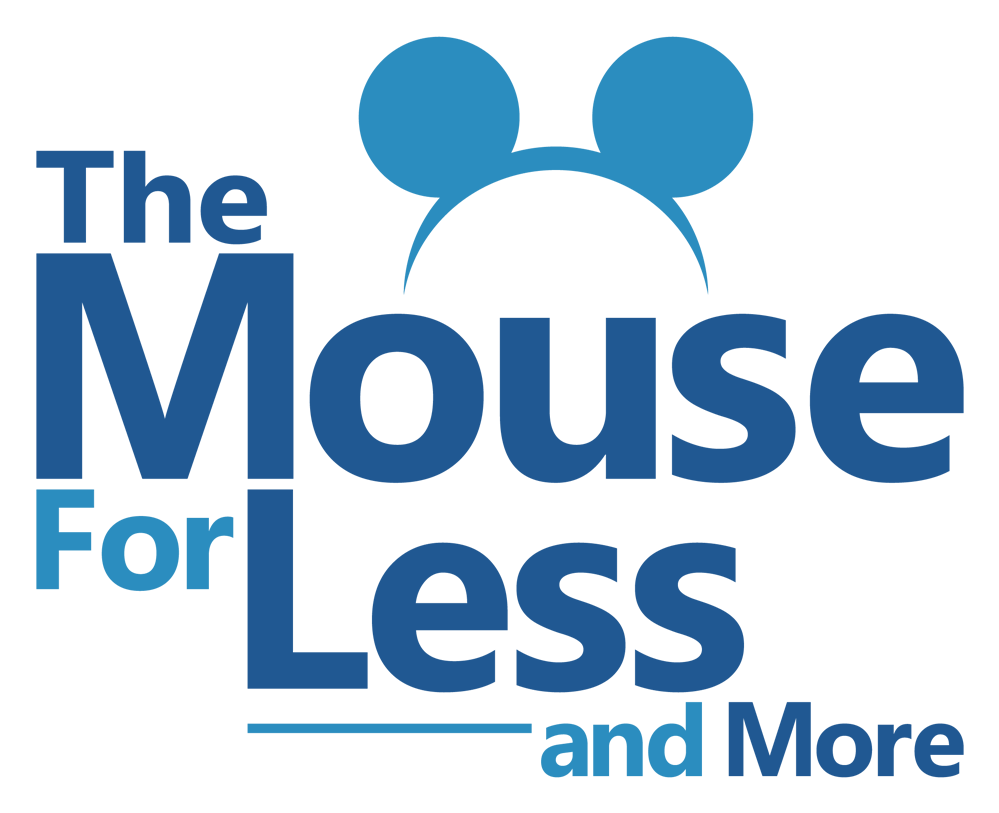
At The American Adventure, guests enjoy a patriotic celebration of American history, featuring animatronics, film, and music. The American Adventure is the name of both the show and the overall pavilion. The American Adventure stands alone among World Showcase’s eleven pavilions in not possessing the name of an actual country. In addition, the building is based on late-18th century Georgian architecture, the buildings of Colonial Williamsburg, Independence Hall, the Old State House in Boston, and Thomas Jefferson’s Monticello. The structure incorporates 110,000 handmade bricks, and the roof is made of slate.
Ride Information Restrictions Location Fun Facts Top 5 Tips
Ride Information
Opening Day: October 1, 1982
Type of Ride: Elaborate theater presentation
Age Recommendation: Older children and adults
Duration of Ride: About 29 minutes
Typical Queue Time: Shows typically start every 45 minutes
Single Rider Line: No
Chicken Exit Available: No
Baby Swap Available: No
Type of Vehicle: None
Type of Restraint: None
Attraction Open During Early Theme Park Entry: No. See our Early Theme Park Entry page for more information.
Ride Photo Available For Purchase: No

Ride Restrictions
Height Requirements: None.
Flash Photography or Video Allowed: No

Location
Shopping: Visit “The Art of Disney” store to purchase the latest Disney art, prints, figurines, and more! In addition, there is a Kidcot station nearby.
Dining/Refreshment: Guests can enjoy a counter service lunch or dinner at Regal Eagle Smokehouse: Craft Drafts & Barbecue. This establishment offers ribs, pulled pork, brisket, burgers, baked beans, cole slaw, and mac and cheese. Enjoy snacks like, ice cream and popcorn at the Fife and Drum Tavern. Additionally, Funnel cakes are sold in the pavilion.
Restroom: There are restrooms located at the back of The American Adventure pavilion on both sides.
Smoking Location: Smoking is permitted in designated smoking areas only. Disney parks are smoke free.
Entertainment: Check the times guide to enjoy “The Voices of Liberty.” Typically, they perform before “The American Adventure” show.
The American Adventure Fun Facts
Did you know?
- To start, The American Adventure building is based on late-18th century Georgian architecture, the buildings of Colonial Williamsburg, Independence Hall, the Old State House in Boston, and Thomas Jefferson’s Monticello. The structure incorporates 110,000 handmade bricks. In addition, the roof is made of slate.
- The American Adventure’s lobby features a series of inspirational sayings, paintings, and carvings of American eagles. A separate room, the “American Heritage Gallery,” serves as an evolving museum—exhibits change often—with assorted artifacts. Previous offerings have included a chair used by Benjamin Franklin and a Thomas Edison phonograph.
- Consequently, The American Adventure theater features twelve statues that highlight various American qualities, such as compassion, freedom, individualism, and innovation. In addition, The theater also incorporates eight crystal chandeliers.
- The American Adventure utilizes 35 advanced animatronic figures. Animatronics of Benjamin Franklin and Mark Twain host the presentation. Other animatronics represent Thomas Jefferson, Revolutionary War soldiers, Frederick Douglass, Matthew Brady, a mid-19th century American family, Chief Joseph, Susan B. Anthony, Thomas Edison, Andrew Carnegie, Will Rogers, Alexander Graham Bell, Theodore Roosevelt, John Muir, average Americans during the Great Depression, Franklin D. Roosevelt, and Rosie the Riveter.
- When The American Adventure was being developed in the late-1970s, a third host animatronic was intended to represent the twentieth century. Originally, imagineers decided on Will Rogers. However, surveys indicated that few guests were familiar with Rogers, and Franklin and Twain were left as a duo.
- Topics covered in The American Adventure include the landing of the Mayflower; the contentious policies of Parliament that facilitated the American Revolution; the Declaration of Independence; the Continental Army’s disastrous winter, 1777-78, at Valley Forge, Pennsylvania; slavery, abolitionism, and the Civil War; immigration; Native American policy; women’s rights; new inventions; environmentalism and the formation of national parks; World War I; Charles Lindbergh’s transatlantic flight; the Great Depression; Pearl Harbor and World War II; and the journey into the twenty-first century. Therefore, the attraction provides a good overview of history.
- For example, the songs in The American Adventure include “New World Bound,” “In the Days of ’76,” “Two Brothers,” “Brother, Can You Spare a Dime?,” and “Golden Dream.” Moreover, These numbers voice the coming of settlers to America, the American Revolution, the Civil War, the Great Depression, and progress since World War II, respectively. The traditional Christmas tune “I’ll Be Home for Christmas” is played during the World War II segment. Consequently, guests will hear familiar tunes and learn new songs.
- In fact, “The American Adventure” is one of two Walt Disney World attractions based on actual United States history, The Hall of Presidents at the Magic Kingdom being the other.
Hidden Mickeys:
You can find a Hidden Mickey amidst roses on a lady’s hat in a painting on the left side of the lobby.
Sponsored Ad: Learn more about Hidden Mickey details and location throughout Walt Disney World in A Field Guide to Walt Disney World’s Best Kept Secrets ![]() .
.
Top 5 Tips for The American Adventure

- Most importantly, “The American Adventure” is a must-see attraction for history buffs.
- Take in the details featured throughout the attraction, including those before the show proper.
- Enjoy the lovely music during the show. “Two Brothers” is an especially beautiful number.
- The American Adventure, along with the rest of World Showcase, typically opens at 11 AM, two hours after Future World.
- Guests ascend to the actual theater via stairs or escalator. Also, an elevator is provided for guests in wheelchairs.
- The stairs and escalator sit below more than forty flags pertaining to various places, events, and moments in American history, including the Alamo, the colony of New Sweden, and the Stamp Act crisis.


